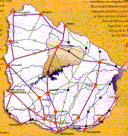 |
|
International Arts Laboratory Tacuarembó
- San Gregorio - Paso de Los Toros
URUGUAY : 19 - 25 september |
| Excentra
is not an event of the arts of conventional type, like a biennial or the
traditional arts hall. We did not exclude that a part of it has characteristics
of a traditional event, and perhaps this operates as a form of conceptual
anchorage from conceivable codes for the public.
But the innovating part of the event, proposing to leave the conventional format, lies in the intention of being a true laboratory of the arts. It will end also contributing with a product with spectacle characteristics and without a doubt being a promotional modality of transformation in the conception of the artistic question for this new millennium. Excentra, as a concept, makes reference to a escape of the center. This has been the characteristic tension of the Art in history. The nature of the Art has been and is the creation, the innovation, the originality, the rupture, the transgression. The center represents the established, the conventional, therefore the creative force proposes the exploration in the margins of the already known territory. The center is constituted, by the pre-conceptions that we handle around of what the art is, and that the art itself takes care to reformulate, to transgress, to put at issue; in some way according with Joseph Kosuth: "...the art is the definition of the art..." As well as the art has escaped from the object to the concept; of the classic categories to the sprouting of new categories or to the dissolution of them; towards new forms of conception of the responsibility and relationship of the artist with its public. Thus also escaping towards the exotic to the use of the vanguards of century principle... In the same way Excentra sets out and proclaims event of the Arts in process and progress, a new context of production, the artistic practice as an event, beyond products and protagonists; redimensioning the conditions of reception of works and the relationship of the public with these and the authors. Excentra,
transforms to the city/town/habitat in atelier, in a laboratory of the
Arts, where the inhabitants and the visitors have the opportunity of
turning from
The
in progress and process condition implies transformations during the
process of execution of the project, being the own recollection of this
one, part of the product. The
final product, is conceived, in its dimension of spectacle, like a Biennial
of traditional art as much in its monumentality and aesthetic quality,
like in its potential of picking up interest of the public and the international
artistic community. The present condition of the Art causes that their proposals are opened to interdisciplinary integration, at the same time which also opens to the investigation, speculation and reformulation of the classic. Permanent samples in the style of the halls, as well as workshops in execution, and events that will take place in the urban space or closed locals, possibly traveling events, that will fill of colorful daily living, they will urge the reflection and the aesthetic benefit to those who have the opportunity to live this event. Excentra
is an event of the visual arts, that involves all the orders of the
citizen life, causing and motivating local people, in the inherent thing
to its reality, its identity and to the image that creates or tries
to project to those of outside. It is an event trigger and its reach
extends the one of a space where the art is if same or it is watched
in the mirror. The proposal is to go beyond, in a format of extensionist
type, of sensibilization of the local population, to promote its creativity,
to incursion in diverse challenges to discover and to expand the own
potential. In
the dimension of the cultural democratization, Excentra do not afiliate
exclusively to the concept of which this one happens to make the cultural
goods to the greater amount accessible of possible population, (in such
case the works of art made by artists of reputation), but also it includes
in its conception of cultural democracy, to the inherent thing to the
access of the citizen to the own production of the cultural good. In
such sense, the dynamics of Excentra contemplates it, without the artist
of reputation loses his condition of so, but promoting new concepts
and new reflections and at the same time generating new challenges,
as much for the artist as for the society. Searching
for keys for the democratization of art, can mean, to face against the
discovery, of which if a true Art exists, it should be accessible to
all men, and this access is through humanization. The history of the
Art, can be perceived, doubtlessly, as the study of the process of accumulation
of proposals, represented by works and artists of different times. But
also can be like the process of the construction of the glance of our
culture. From the kitchen of Leonardo to the Cock- art, Food-performance and other modalities of ephemeral art. The
space of the gastronomy, it was at its moment, object of speculation
on the part of Leonardo Da Vinci, like more of its innumerable facets.
These incursions of the famous artist constitute source of inspiratio
for a series of proposals and investigations, from which it appears
the promise of new categories that are opened like possibilities for
the creation; for new explorations of our sensitivity and our culture. |
|
PARTICIPANT
ARTISTS
|
|
|
Uruguay
España
|
Argentina Polen Sweden
|
| SPONSORS Unidad de Educación Permanente del Instituto escuela Nacional de Bellas Artes. Universidad de la República. Intendencia Municipal de Tacuarembó. Junta de San Gregorio de Polanco. Fundación Tacuarembó. Instituto Universiotario BIOS. CO-CURADORS Ximena Narea |
|
Links
|
|||
 Taller Clever Lara |
 Ana María Poggi |
||
 Octavio Podestá |
 Guillermo Bush |
||
|
Other
links
|
IENBA
 |
||
Webbmaster: Ximena Narea

